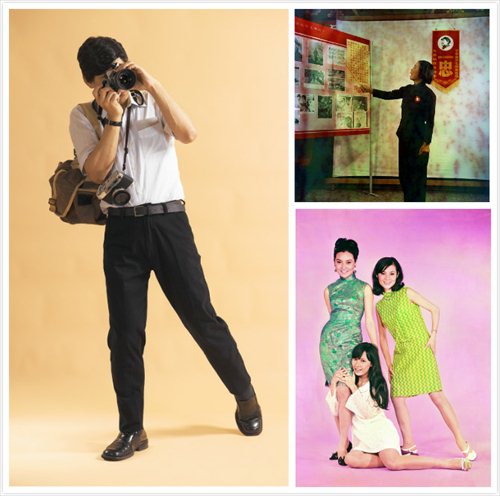Caught in context
After reviewing the evolution of photography on the Chinese mainland in last year's Grain to Pixel, the Shanghai Center of Photography is now examining photography's role in cementing an image of Hong Kong in the popular consciousness with new exhibition Figures of Speech.
The exhibition, [curated by Karen Smith], features six photographers - Fan Ho, Yau Leung, Meng Minsheng, Leung Chi-wo, Sara Wong and Stanley Fung - who were either born or based in Hong Kong. Exhibits were created from the 1950s onwards.
"They come from different social backgrounds, but together their works form a surprisingly social and cultural tableau of Hong Kong that is unusually evocative. The results are contextually real but stylistically diverse," said Liu Heung-shing, the Pulitzer Prize-winning photographer and founder of the center.

(Clockwise from above left) Photojournalist with Two Cameras by Leung Chi-wo and Sara Wong, Propaganda Secretary of Mao Zedong Thought by Meng Minsheng, and Actresses of Shaw Brothers by Yau Leung Photos: Courtesy of Shanghai Center of Photography
Leading figures
The exhibition begins with three portraits by Fan Ho, who is widely considered as Hong Kong's best-known and most highly regarded photographer. Arriving in Hong Kong as a teenager in 1949, he began photographing almost immediately.
The portraits, taken between 1952 and 1956, capture stage actors and photographer friends of Fan Ho, and deftly assert his storytelling skills.
Yau Leung (1941-97), who is best remembered for his images of actresses adorning the cover of countless film magazines, is represented here by a collection of his celebrity works.
Film stars from the 1970s posed before single-color backdrops, their costumes and smiles immortalizing the trend and vogue of that bygone era.
Meanwhile, Meng Minsheng (1919-2007), who grew up in Hong Kong and joined the Hong Kong Federation of Trade Unions in the late 1940s, expressed his political leaning in the series Imitated Revolution.
He created painted backdrops and simple sets, and had people pose as if they were dictating Mao Zedong's guidelines, or performing a model opera (stories of revolutionary struggles against foreign and class enemies planned and engineered by Mao's wife Jiang Qing).
However surreal these staged photographs seem today, that sense of parody, by hindsight, might just be their charm.
"Meng Minsheng's actual intent was earnest, innocent, driven by a youthful enthusiasm for a cause. The series reveals the fallibility of the presentation, of the clash between constructed scene and the camera's truth," American photographer Duane Michals said.
Another photographer who takes pictures to reveal and encourage his ideals is Stanley Fung, a pastor of the Rhenish Church who was born in Hong Kong and moved to Taiwan as a child.
In the series Dust Icon, Fung photographed friends and followers of his church in a rented studio just above the church. Each subject represented a persona from the Bible, for example David the young shepherd boy, Noah, and the Virgin Mary.
Chen Siya, who works on the center's exhibition team, called attention to The Lord's Handmaiden in particular.
It portrays Kuo Hsiao-wen, a gospel singer from Taiwan's Palawan tribe, six days before her death.
Kuo was diagnosed with colon cancer when she was pregnant, but rejected the idea of terminating another life for her own sake and endured tremendous pain to give birth to a healthy baby girl.
When her husband asked Fung to photograph her, she told the photographer that they only had this one chance to take pictures.
In this subtly moving picture, a skinny Kuo sits under a clock and looks straight into the camera, her expression ambiguous, mysterious and yet so serene.
"You don't need to side with or understand his religion at all to feel the impact of the great human qualities that he conveyed through the lens," Chen told the Global Times.
The renowned Taiwan photographer Juan I-jong, who taught Fung, said these portraits exude a sense of "spiritual sublimation," and show that "even a humble mortal can become extraordinary."
Most contemporary works
The most contemporary works are from duo Leung Chi-wo and Sara Wong, who were born in 1968 and continue to work and live in Hong Kong today.
They re-enacted images of anonymous figures picked from old magazines, newspapers, pamphlets, souvenir books and other materials collected over the years in 28 self-portraits, which make up He Was Lost Yesterday and We Found Him Today (2010-2014).
For example, they play a curly bobbed Japanese housewife scratching her back, an office lady with a red umbrella, or a US navy man taking shots with a camera.
"They stayed in the postures for more than 10 minutes and tried to feel as if they were the photographed figures themselves. Nevertheless, the real identities remained unknown," Chen said.
Duane Michals said the series highlights the impossibility of repeating an image. This parallels Roland Barthes' analysis that an idea a photographs points to "could never be repeated existentially."
She said the impossibility of identifying an anonymous person from the past as caught in a photographic image is a romantic encounter with history for the artists.
"It is experience in a most humble but vivid way and permits the existential aspects of their gesture and posture to exert a forceful fascination, which underscores the poetics of photography in portraying the human figure," Duane Michals said.
Date: Until February 29, 10:30 am to 5:30 pm (closed Mondays)
Venue: Shanghai Center of Photography
Address: 2555-1 Longteng Avenue
龙腾大道2555号-1
Admission: 40 yuan ($6.07)
Call 6428-9516 for details